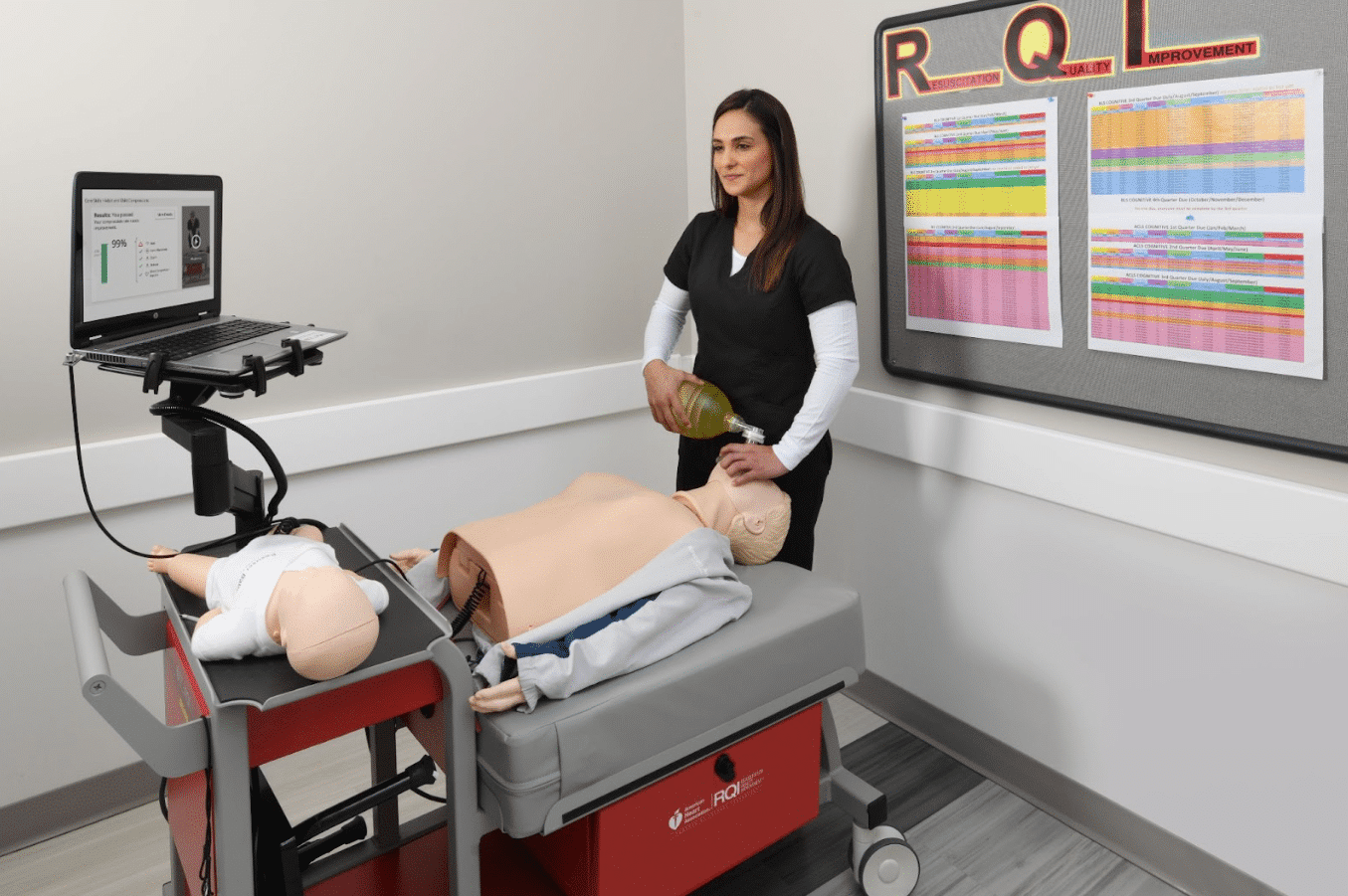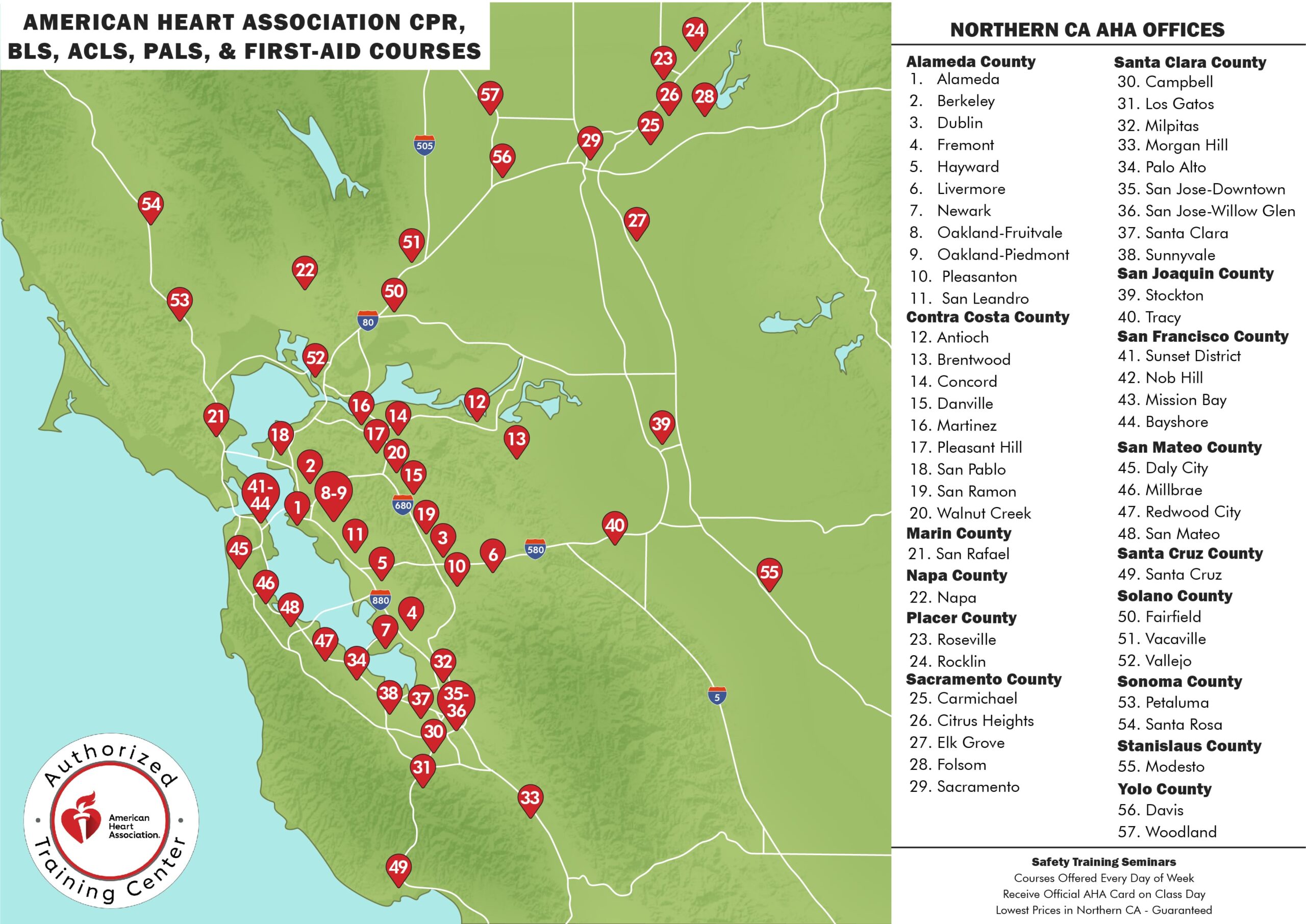
American Heart Association Course Registration
Safety Training Seminars recently moved out of our Manteca CPR office, but we have other locations nearby. We offer American Heart Association CPR, BLS, ACLS, and PALS courses near Manteca, CA in Tracy, Livermore or Stockton. We can teach CPR & First-aid classes at your location any day of the week. Ask us about our group discounts.
American Heart Association Course Registration
Safety Training Seminars recently moved out of our Manteca CPR office, but we have other locations nearby. We offer American Heart Association CPR, BLS, ACLS, and PALS courses near Manteca, CA in Tracy, Livermore or Stockton. We can teach CPR & First-aid classes at your location any day of the week. Ask us about our group discounts.
What is American Heart Association RQI
The American Heart Association RQI (Resuscitation Quality Improvement) program is one of the most popular, modern, and efficient ways for medical and healthcare professionals to receive their official American Heart Association BLS, ACLS, and PALS certification cards.
Three Easy Steps
1. Take the American Heart Association online course at home (a few hours).
2. Arrive to one of our 45 local offices and practice with the VAM (voice assisted manikin).
3. Receive your certification card on the day of the class.

About American Heart Association RQI
How To Pass Your CPR Class
Manteca, California Medical Facilities: A Beacon of Healthcare Excellence
Nestled in the heart of California’s San Joaquin Valley, Manteca is a vibrant city with a lot to offer, including top-notch medical facilities that cater to the healthcare needs of its residents and neighboring communities. As the population in this region continues to grow, so does the demand for quality healthcare services. Thankfully, Manteca’s medical facilities are rising to the challenge, providing a comprehensive range of healthcare services and cutting-edge technology to ensure the well-being of its residents.
Diverse Healthcare Providers
Manteca boasts a diverse range of healthcare providers, including hospitals, clinics, and specialty centers. The jewel in Manteca’s healthcare crown is the Doctors Hospital of Manteca. This acute care facility, part of the Tenet Healthcare network, is renowned for its exceptional healthcare services. It provides comprehensive medical care, including emergency services, surgical procedures, diagnostic imaging, and more. With state-of-the-art technology and a team of dedicated healthcare professionals, Doctors Hospital of Manteca is a beacon of hope for those seeking advanced medical care.
For those looking for specialized healthcare services, Manteca offers several specialty clinics. The Manteca Heart Center is a prime example. This facility focuses exclusively on heart health, offering services like cardiac screenings, stress tests, and interventional cardiology procedures. The center’s skilled cardiologists and cutting-edge technology make it a vital resource for those dealing with heart-related issues.
Community-Centric Care
Manteca’s medical facilities are not just places to receive treatment; they are deeply rooted in the community. The Manteca Community Care Clinic is a testament to this commitment to community health. This clinic provides essential primary care services to residents, regardless of their ability to pay. From routine check-ups to managing chronic conditions, the dedicated healthcare professionals at this clinic are ensuring that everyone in Manteca has access to quality healthcare.
Additionally, Manteca recognizes the importance of mental health and well-being. The Manteca Behavioral Health Center offers a range of mental health services, including counseling and therapy, to help individuals cope with the challenges of modern life. Their focus on mental health reflects the city’s holistic approach to healthcare.
Innovation and Technology
Manteca’s medical facilities are not just keeping pace with the latest advancements in healthcare technology; they are at the forefront of innovation. One prime example is the Manteca Imaging Center, which offers advanced diagnostic imaging services. Whether it’s MRI, CT scans, or ultrasound, this center provides state-of-the-art technology for accurate diagnoses.
Telemedicine has also gained prominence in Manteca’s healthcare landscape. Many medical facilities in the city now offer telehealth services, allowing patients to consult with healthcare professionals from the comfort of their homes. This has been especially vital during the COVID-19 pandemic when in-person visits were restricted.
A Healthy Future
As Manteca continues to grow, its commitment to healthcare remains steadfast. Plans for expanding existing facilities and developing new ones are in motion, ensuring that the city can meet the healthcare needs of its residents well into the future. The focus on preventative care and community health programs also promises a healthier future for Manteca’s residents.
In conclusion, Manteca, California, is not just a thriving city; it’s a place where healthcare excellence is a priority. With a diverse array of medical facilities, a strong sense of community, and a dedication to innovation, Manteca ensures that its residents receive the best possible healthcare services. As the city continues to evolve, so too will its healthcare offerings, making Manteca a model for healthcare excellence in California and beyond. Whether you’re a resident or a visitor, you can rest assured that your healthcare needs will be well taken care of in Manteca.
Life-Saving Skills: Exploring CPR, BLS, ACLS, and PALS Classes
In the realm of emergency medical care, few skills are as crucial as Cardio-Pulmonary Resuscitation (CPR) and Advanced Cardiac Life Support (ACLS), Basic Life Support (BLS), and Pediatric Advanced Life Support (PALS) techniques. These life-saving techniques form the backbone of first response and medical intervention, often making the difference between life and death in critical situations. Let’s delve into the significance of each of these classes and their role in maintaining public health and safety.
Cardio-Pulmonary Resuscitation (CPR): CPR is a fundamental life-saving technique that can be administered by trained individuals to sustain blood circulation and provide artificial respiration when a person’s heart has stopped beating. CPR involves a combination of chest compressions and rescue breaths, aimed at keeping oxygenated blood flowing to vital organs until professional medical help arrives. CPR classes provide participants with the skills to recognize cardiac arrest, perform effective chest compressions, and deliver rescue breaths. These classes are vital for both medical professionals and laypersons, empowering them to respond swiftly and effectively in emergencies.
Basic Life Support (BLS): BLS takes CPR skills to the next level by incorporating additional techniques and equipment usage. BLS classes are designed for healthcare providers, including doctors, nurses, paramedics, and emergency medical technicians (EMTs). Participants learn how to assess a patient’s condition, deliver high-quality CPR, and use automated external defibrillators (AEDs) to restore a regular heartbeat. BLS training emphasizes teamwork, effective communication, and quick decision-making to optimize patient outcomes during cardiac emergencies.
Advanced Cardiac Life Support (ACLS): ACLS is an advanced course tailored for healthcare professionals who are involved in the management of cardiac arrest and other cardiovascular emergencies. ACLS builds upon the foundation of BLS and focuses on identifying and treating potentially life-threatening conditions such as stroke, myocardial infarction, and arrhythmias. Participants learn to interpret electrocardiograms (ECGs), administer medications, and perform advanced airway management. ACLS classes equip medical personnel with the skills to respond confidently to complex cardiac scenarios, ensuring comprehensive care for critically ill patients.
Pediatric Advanced Life Support (PALS): PALS training is geared towards healthcare providers who care for infants and children during emergencies. Pediatric patients have unique physiological needs, making PALS classes essential for those working in pediatrics, emergency medicine, and intensive care. PALS courses cover topics such as pediatric assessment, effective respiratory support, and the management of pediatric cardiac arrest. Participants gain the knowledge and skills necessary to provide specialized care and interventions that can make a critical difference in the outcomes of pediatric emergencies.
NRP, or Neonatal Resuscitation Program, is a critical medical initiative that focuses on saving newborns who struggle to breathe at birth. This specialized training equips healthcare providers with the skills to assess and manage respiratory distress in infants. NRP emphasizes a systematic approach, teaching effective ventilation techniques and chest compressions if needed. Regularly updated guidelines ensure that participants stay current with the best practices in neonatal care. By enhancing healthcare professionals’ abilities to respond swiftly and effectively to newborn respiratory challenges, NRP plays a vital role in improving infant survival rates and ensuring a healthier start to life.
First-aid classes offer indispensable life skills that empower individuals to respond confidently in emergencies. These structured courses cover a spectrum of situations, from minor injuries to critical incidents, teaching participants how to provide immediate care before professional help arrives. Participants learn to administer CPR, treat wounds, manage choking, and address common health crises. Hands-on training fosters essential skills and boosts confidence, enabling swift and effective action in times of need. First-aid classes are invaluable for workplaces, homes, and communities, creating a network of capable first responders. Mastering these skills not only saves lives but also fosters a safer and more prepared society.
Incorporating these life-saving techniques into healthcare systems, workplaces, and communities can significantly enhance the response to medical emergencies. Quick and effective interventions provided by individuals trained in CPR, BLS, ACLS, and PALS can stabilize patients and improve their chances of survival before professional medical assistance arrives. Moreover, these classes promote a culture of preparedness, empowering individuals to step forward and take action when faced with emergency situations.
In conclusion, American Heart Association CPR, BLS, ACLS, and PALS classes play an indispensable role in equipping individuals with the skills and knowledge needed to respond effectively to various medical emergencies. These courses bridge the gap between bystander assistance and professional medical care, ultimately contributing to improved patient outcomes and increased survival rates. By investing in these life-saving classes, individuals and healthcare professionals alike become vital links in the chain of survival, ensuring that timely and appropriate care is delivered when it matters most.
Our Blog

Why CPR is Important in Healthcare
Cardio-pulmonary resuscitation (CPR) is a life-saving technique that everyone should know how to perform. It involves a series of actions designed to help someone who has stopped breathing or whose

7 Common CPR Myths Debunked
Cardiopulmonary resuscitation (CPR) is a life-saving technique that can help a person in the event of cardiac arrest. It involves chest compressions that are performed until medical professionals arrive or

Importance of Workplace CPR & First-Aid Training
Accidents can happen anytime and anywhere, even in the workplace. Although we may try our best to ensure a safe and healthy work environment, we can’t predict or prevent all


